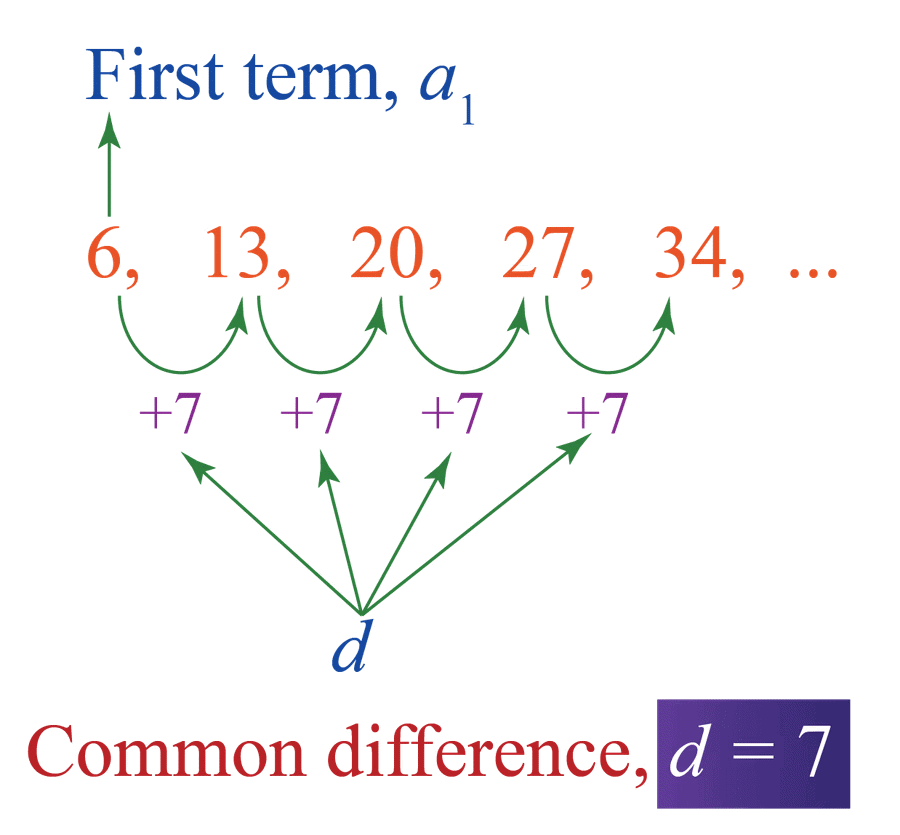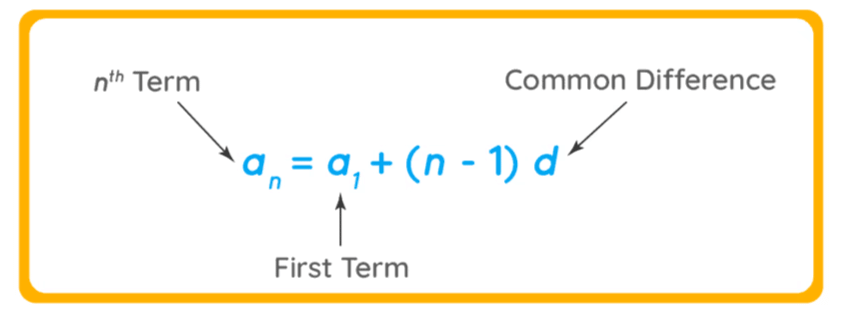Arithmetic Progression: Introduction & Solved Examples | CSAT Preparation - UPSC PDF Download
| Table of contents |

|
| What is Arithmetic Progression? |

|
| Notation in Arithmetic Progression |

|
| Arithmetic Progression Formulas |

|
| Solved Examples on Arithmetic Progression |

|
What is Arithmetic Progression?
A progression is a special type of sequence for which it is possible to obtain a formula for the nth term. The Arithmetic Progression is the most commonly used sequence in maths with easy to understand formulas.

- Definition 1: A mathematical sequence in which the difference between two consecutive terms is always a constant and it is abbreviated as AP.
- Definition 2: An arithmetic sequence or progression is defined as a sequence of numbers in which for every pair of consecutive terms, the second number is obtained by adding a fixed number to the first one.
- The fixed number that must be added to any term of an AP to get the next term is known as the common difference of the AP. Now, let us consider the sequence, 1, 4, 7, 10, 13, 16,…
It is considered as an arithmetic sequence (progression) with a common difference 3.
Notation in Arithmetic Progression
In AP, we will come across some main terms, which are denoted as:
- First term (a)
- Common difference (d)
- nth Term (an)
- Sum of the first n terms (Sn)
All three terms represent the property of Arithmetic Progression. We will learn more about these three properties in the next section.
First Term of AP
The AP can also be written in terms of common differences, as follows;
a, a + d, a + 2d, a + 3d, a + 4d, ………. ,a + (n – 1) d
where “a” is the first term of the progression.
 First Term and Common Difference of AP
First Term and Common Difference of AP
Common Difference in Arithmetic Progression
In this progression, for a given series, the terms used are the first term, the common difference and nth term. Suppose, a1, a2, a3, ……………., an is an AP, then; the common difference “ d ” can be obtained as;
d = a2 – a1 = a3 – a2 = ……. = an – an – 1
Where “d” is a common difference. It can be positive, negative or zero.
General Form of an AP
Consider an AP to be: a1, a2, a3, ……………., an
Position of Terms | Representation of Terms | Values of Term |
1 | a1 | a = a + (1-1) d |
2 | a2 | a + d = a + (2-1) d |
3 | a3 | a + 2d = a + (3-1) d |
4 | a4 | a + 3d = a + (4-1) d |
. | . | . |
. | . | . |
. | . | . |
. | . | . |
n | an | a + (n-1)d |
Arithmetic Progression Formulas
There are two major formulas we come across when we learn about Arithmetic Progression, which is related to:
- The nth term of AP
- Sum of the first n terms
nth Term of an AP
The formula for finding the n-th term of an AP is:an = a + (n − 1) × d
Where ,
a = First term
d = Common difference
n = number of terms
an = nth term
Example: Find the nth term of AP: 1, 2, 3, 4, 5…., an, if the number of terms are 15.
Solution: Given, AP: 1, 2, 3, 4, 5…., an
n=15
By the formula we know, an = a+(n-1)d
First-term, a =1
Common difference, d=2-1 =1
Therefore, an = a15 = 1+(15-1)1 = 1+14 = 15
Note: The behaviour of the sequence depends on the value of a common difference.
- If the value of “d” is positive, then the member terms will grow towards positive infinity
- If the value of “d” is negative, then the member terms grow towards negative infinity
Types of AP
Finite AP: An AP containing a finite number of terms is called finite AP. A finite AP has a last term.For example: 3,5,7,9,11,13,15,17,19,21
Infinite AP: An AP which does not have a finite number of terms is called infinite AP. Such APs do not have a last term.
For example: 5,10,15,20,25,30, 35,40,45………………
Sum of N Terms of AP
For an AP, the sum of the first n termscan be calculated if the first term, common difference and the total terms are known. The formula for the arithmetic progression sum is explained below:Consider an AP consisting “n” terms.
Sn = n/2[2a + (n − 1) × d]
This is the AP sum formula to find the sum of n terms in series.
Proof: Consider an AP consisting “n” terms having the sequence a, a + d, a + 2d, …………., a + (n – 1) × d
Sum of first n terms = a + (a + d) + (a + 2d) + ………. + [a + (n – 1) × d] ——————-(i)
Writing the terms in reverse order,we have:
Sn= [a + (n – 1) × d] + [a + (n – 2) × d] + [a + (n – 3) × d] + ……. (a) ———–(ii)
Adding both the equations term wise, we have:
2Sn = [2a + (n – 1) × d] + [2a + (n – 1) × d] + [2a + (n – 1) × d] + …………. + [2a + (n – 1) ×d] (n-terms)
2Sn = n × [2a + (n – 1) × d]
Sn = n/2[2a + (n − 1) × d]
Example: Let us take the example of adding natural numbers up to 15 numbers.
AP = 1, 2, 3, 4, 5, 6, 7, 8, 9, 10, 11, 12, 13, 14, 15
Given, a = 1, d = 2-1 = 1 and an = 15
Now, by the formula we know;
Sn = n/2[2a + (n − 1) × d]
S15 = 15/2[2.1+(15-1).1]
= 15/2[2+14]
= 15/2 [16]|
= 15 x 8
= 120
Hence, the sum of the first 15 natural numbers is 120.
Sum of AP when the Last Term is Given
Formula to find the sum of AP when first and last terms are given as follows:
S = n/2 (first term + last term)List of Arithmetic Progression Formulas
The list of formulas is given in a tabular form used in AP. These formulas are useful to solve problems based on the series and sequence concept.
General Form of AP | a, a + d, a + 2d, a + 3d, . . . |
The nth term of AP | an = a + (n – 1) × d |
Sum of n terms in AP | S = n/2[2a + (n − 1) × d] |
Sum of all terms in a finite AP with the last term as ‘l’ | n/2(a + l) |
Solved Examples on Arithmetic Progression
Below are the problems to find the nth term and the sum of the sequence, which are solved using AP sum formulas in detail. Go through them once and solve the practice problems to excel in your skills.Example 1: Find the value of n, if a = 10, d = 5, an = 95.
Solution: Given, a = 10, d = 5, an = 95
From the formula of general term, we have:
an = a + (n − 1) × d
95 = 10 + (n − 1) × 5
(n − 1) × 5 = 95 – 10 = 85
(n − 1) = 85/ 5
(n − 1) = 17
n = 17 + 1
n = 18
Example 2: Find the 20th term for the given AP:3, 5, 7, 9, ……
Solution: Given,
3, 5, 7, 9, ……
a = 3, d = 5 – 3 = 2, n = 20
an = a + (n − 1) × d
a20 = 3 + (20 − 1) × 2
a20 = 3 + 38
⇒a20 = 41
Example 3: Find the sum of the first 30 multiples of 4.
Solution:The first 30 multiples of 4 are: 4, 8, 12, ….., 120
Here, a = 4, n = 30, d = 4
We know,
S30 = n/2 [2a + (n − 1) × d]
S30 = 30/2[2 (4) + (30 − 1) × 4]
S30 = 15[8 + 116]
S30 = 1860
Example 4:Find the series whose nth term is . Is it an A. P. series? If yes, find 101st term.
Solution: Putting 1, 2, 3, 4…. We get T1, T2, T3, T4…………..
As the common differences are equal
∴The series is an A.P.
Example 5: A student purchases a pen for Rs. 100. At the end of 8 years, it is valued at Rs. 20. Assuming
that the yearly depreciation is constant. Find the annual depreciation.
Solution: Original cost of pen = Rs. 100
Let D be the annual depreciation.
∴ Price after one year = 100 - D = T1 = a (say)
∴ Price after eight years = T8 = a + 7 (- D) = a - 7D
= 100 - D - 7D = 100 - 8D
By the given condition 100 - 8D = 20
8D = 80
∴D = 10.
Hence annual depreciation = Rs. 10.
|
205 videos|264 docs|136 tests
|
FAQs on Arithmetic Progression: Introduction & Solved Examples - CSAT Preparation - UPSC
| 1. What is an arithmetic progression? |  |
| 2. How can I find the nth term of an arithmetic progression? |  |
| 3. Can an arithmetic progression have a negative common difference? |  |
| 4. How can I find the sum of an arithmetic progression? |  |
| 5. Is it possible for an arithmetic progression to have an infinite number of terms? |  |






















